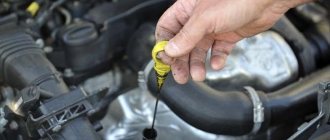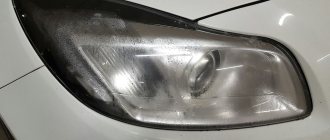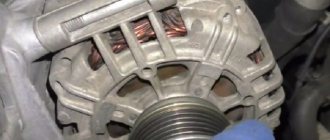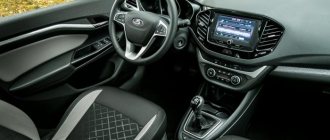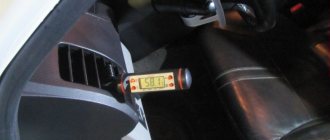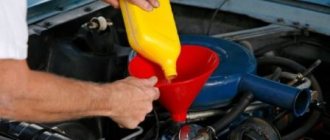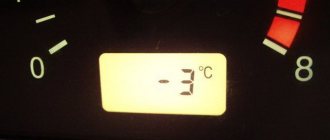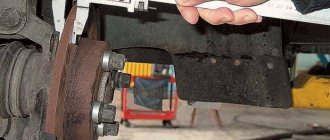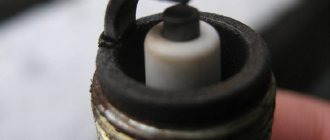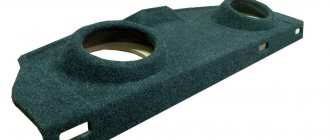TOP 10 reasons for a hum when driving a car
Therefore, we have selected the most common causes of extraneous noise and hum in the car:
- wheel bearing;
- engine;
- checkpoint;
- exhaust system;
- brake discs/pads;
- steering;
- cooling system;
- rear axle;
- tires;
- electrical equipment.
Let's look at them in more detail.
Noise due to wheel bearing
It is the most common, obvious “culprit” of an extraneous hum in a car when turning the steering wheel and driving in a straight line. The most common manifestations:
- When turning the steering wheel left or right, the noise is not the same.
- Likewise, the larger the rotation angle, the higher the noise. However, it disappears when the wheels are aligned.
- As the speed increases, the noise under the car becomes unbearable, even if you are moving only 60 km/h. And in especially advanced cases, when the execution of these works simply “burns”, the beating of the steering wheel and vibration of the entire car are added to the noise.
But these are only indirect reasons that the wheel bearing has failed. Although if you find one of them, be sure to take the time and diagnose whether it is faulty or a breakdown somewhere else.
The technology for how to do this on a single-wheel drive car is simple and straightforward. A jack is enough, and it is done without helpers. It is more difficult to do the same with 4x4 cars: you need a lift to hang the car. Plus a stethoscope that allows you to hear extraneous noise in the wheel bearing.
But the given method, when one/all wheels are rotated by hand, you pull them in all planes in order to determine the play, does not give a 100% result. This means that even at the slightest suspicion, you should contact a specialized service station. Driving with a worn bearing, especially when the hum is audible even with just your ear, is downright dangerous.
What can cause extraneous noise in the engine?
Motor. It can also become a source of increased noise if it starts to make a hum at idle speed/during normal operation. Its cause may be wear/loose mounting pads of the power unit. The malfunction is not critical, it can be easily eliminated by tightening the connections, and if necessary, by replacing the cushions themselves with new ones.
Gearbox noise
There are quite a lot of possible malfunctions when a constant or, conversely, intermittent hum occurs when driving. Let's just list them:
- Primary shaft bearing. The one that simply wears out with prolonged use.
- The release bearing is noisy. This is easy to check: if the sound disappears when switching to neutral speed, it is most likely to blame.
- Failure/natural wear of the CV joint. Alternatively, the boot could not stand up to use and stopped holding lubricant. But change only it or the entire “grenade”, individually in each specific case.
- Finally, any other bearings installed in the gearbox and drive system of the car. On axle shafts, in the transfer case, drive or on the driveshaft.
At the same time, it is often not possible to diagnose a malfunction without special skills and appropriate equipment to determine what exactly is the source of extraneous noise. There is only one right decision in this situation - you go straight to the station.
In addition, as with the power unit, do not forget about its supports, they can also delaminate. And don't forget to check the oil level in the box. Regardless of its type: manual, classic automatic or CVT. Due to oil starvation, the car may also make extraneous noise when driving.
Car exhaust system
Unlike a motor-gearbox, it is much simpler. Therefore, there will also be much fewer possible malfunctions:
- we lost the attachment from the exhaust pipe when we drove to the dacha along the dirt road;
- similarly, they bent it while driving off a curb in the city.
All.
Brake circuit: what could be humming in it?
The brake pads are squeaking or squeaking, as anyone can hear. The harder you press the pedal, the louder the sound. But to determine whether the pads have worn out, whether the disk/drum is damaged, or whether some foreign object is stuck in the mechanism, removing the wheel will help.
Not an obvious cause: car steering
Many will ask the question: what does he have to do with it? And they will be wrong, since the cause may be power steering. Both the pump itself and the hoses. Therefore, if, after starting the engine after parking in the cold, noises first appear and then disappear, be sure to inspect this unit.
Extraneous noise in the cooling system
In the pump, especially after a long mileage, the bearing wears out. The coolant flows unevenly, the power unit overheats, which can lead to capital leaks. Try to replace the bearing as soon as you determine this problem.
Plus, be sure to check the condition of the air conditioner bearing; it may also hum when turned on.
Rear axle: another possible source of hum
In a rear-/all-wheel drive vehicle, the lubricant in the rear axle may leak. Checking its level, topping it up, and, if necessary, changing it completely is a way to extend the life of this unit. And when you do this work, check the universal joint, it can also cause a hum.
Tires on a car
The reasons for this may be:
- Tires are out of season. When in the summer you drive on winter tires, with “toothy tread” and even with studs.
- Poor balancing. When braking, you feel not only an increased rumble, but also a beating. There is only one way out - a tire workshop.
- Incorrect installation. Most tires sold today are directional: an arrow on the cord will tell you how to install them. But there are masters who do not attach any importance to this.
Electrics: the hum can even come from it
More precisely from the generator.
Both the belt tension and the condition of the bearing come under close attention. You can see for yourself that there are 1000 and 1 reasons for the occurrence of an extraneous hum. Therefore, if you don’t want to look for a fault yourself, watch videos on YouTube for hours, walk around with your hands smeared with dirt and oil, come to us.
Here, the technicians will not only determine the malfunction, which component is worn out/broken, but will also advise on repairs: what spare parts are needed, how long it will take, how much the repair will cost.
Crunch in the gearbox.
If your car is equipped with a manual transmission and while driving you hear some kind of crunching noise when changing gears, this may be the first symptom of various problems appearing in the car. As a rule, this is primarily due to the fairly high mileage of the car itself and, secondly, to the natural wear and tear of certain gearbox parts.
To begin with, this crunching sound in the gearbox when changing gears can clearly indicate wear and tear on the synchronizers themselves and other components of the gearbox. Synchronizers, as many of us know, play an important role in any gearbox, equalizing the speed of rotation of the shafts and gears in the transmission to subsequently transmit the required torque at a certain speed.
This crunching noise may also indicate clutch wear. Typically, with this malfunction, this crunching noise appears when the clutch pedal is fully depressed while shifting gears. The same thing usually happens with a working clutch, when you do not fully depress the same clutch pedal.
Causes of natural noises
Before we move on to discussing the possible reasons why there is a strong hum in a car at speed, it is necessary to define the concepts. The fact is that, depending on the degree of sound insulation in different cars, the driver and passengers will still hear some sounds coming from outside the cabin. Therefore, noises can be divided into three groups - natural, unnatural and others. There is no need to be afraid of the reasons why natural and other noises occur, but the sources of unnatural noises require additional diagnostics, since they are indicators of breakdowns.
So, the causes of natural noise include:
- Strong headwind or side wind when driving a car along the highway. This is especially true for driving at high speed and for cars with a small body. To eliminate the hum in this case, it is necessary to slightly reduce the speed.
- Engine operation. Any internal combustion engine makes sounds when running. But if the engine suddenly starts working much louder than before, then additional diagnostics are necessary.
- Driving on a bad road. In particular, when driving on coarse asphalt, there is always more noise than when driving on a smooth surface.
- Open windows. When driving at high speed with the windows open, there will also be increased noise in the cabin.
Liquid sound insulation for the bottom and arches
Liquid sound insulation is used to reduce noise in the cabin while driving. Designed for quickly covering wheel arches and the bottom of a car with a noise-insulating agent in the form of rubber. Read more
All of the above reasons and phenomena do not pose any threat to either the car or the driver and passengers, so you should not be afraid of them. The causes of so-called “other” noise are also harmless phenomena. Among them:
- Plastic creaks in the cabin. People call this phenomenon “cricket”. You can get rid of it using different methods, one of which is the use of silicone grease.
- Roof mounted rack. This applies to a conventional iron lattice rack mounted on the roof of a car (new streamlined models do not have this drawback). Moreover, it is noted that the hum begins to appear already at speeds of 60 km/h and above. The situation is similar if there is any cargo loaded on the trunk. In this case, the noise may be even greater.
Noise 3: wheel noise - more speed - more noise
One of the most difficult noises to diagnose is the droning sound that comes from the wheels and is associated with the vehicle's speed. This noise can be due to both tire tread and wheel bearing wear. The worst thing is that, while in a car while driving, it is difficult not only to make out the noise itself, but also to understand which wheel the hum is coming from. Ultimately, the only way to determine which wheel is noisy is through trial and error.
For example, you can swap the wheels to see if there are any changes. It is quite possible that it will come from the other side. This way, you may get lucky and pinpoint whether the noise is caused by the wheels or the vehicle components.
You can also jack up the car (one wheel at a time) and spin the wheels to listen for signs of wear on the wheel bearings.
Check the tread for uneven tire wear, which could be due to suspension problems or a bad wheel alignment. It is quite possible that due to uneven tread wear, the tires began to make noise. Moreover, the higher the speed, the more such tires will make noise and even buzz. The reason for the hum from under the wheels at speed may be insufficient tire pressure. If you have a pump with a pressure gauge, check the tire pressure or go to a gas station that has a pressure gauge.
Visual inspection
Visually inspect your vehicle for damage
If there is a serious problem with your vehicle, with loading sounds, improper operation, burning odors or smoke, stop as soon as possible to avoid engine damage and possible crash of your vehicle.
If your vehicle is operating normally but you notice a recurring or persistent irregular sound, find a safe location away from traffic to have it checked.
A good place to conduct an inspection is at your home, in your driveway, to ensure safety. Having a helper can be helpful. Using gloves and an old shirt and pants can help because inspecting the car can get dirty.
Here are some tips on what to check during a visual inspection:
- Check your tires and rims to make sure nothing is stuck or making noise.
- Look under the car and see if anything is stuck or scratched on the underbody or other parts of the car.
- With the engine off, check under the hood for anything that seems unusual. (I once had a wire under the hood, probably from the service center when a mechanic was working on my car)
- With the engine off and cool, feel around the engine for anything that may be loose , including belts, hoses, compartments, fans, and any other parts. Check the belts for wear, especially other moving parts.
- Place the vehicle in park and apply the emergency brake. Start the engine and listen and look for anything unusual.
- Ask your partner to press gas pedal for a few seconds and see if you hear or see anything different than before.
- Finally, close the hood and have your partner drive the car up and down the street and listen carefully for sounds and any visual cues that may indicate a problem
After the inspection, write down any problems you saw or heard that were unusual. You can search online for solutions or contact a mechanic. Ask a friend for a second opinion if you are still unsure about what you heard, felt or saw.
By identifying the source of noise in your car yourself, you can save a lot of money.
Nowadays, we all know that due to the increased cost of almost everything, all repairs and maintenance of even an inexpensive car take a heavy toll on the family budget. Naturally, every car owner is not averse to saving on the costs associated with maintaining a car. As a result, today more than ever it is very important to learn how to independently diagnose problems that arise in your car. This can help you save a significant amount in the future. After all, if a fault in a car is not noticed in time, over time the breakdown may become more significant.
Here are some recommendations on how you can independently identify the source of noise in the car, which will allow you to look for the cause of the malfunction in the right direction, and not guess on the coffee grounds, as they now like to do in car repair shops, shaking various components one by one. Here are the main sources of noise in a car:
- Noise when the vehicle speed increases is a possible problem with the wheels.
- Noise from under the hood after increasing engine speed is a possible problem with the engine.
- Random noises that are not related to engine speed or vehicle speed are likely suspension problems or road noise.
Engine rattling or knocking.
If your engine makes a rumbling or thumping-like noise that gets louder as the speed increases, then this may mean that you have a serious problem with your vehicle's powertrain.
If you hear a “knock-knock-knock” sound or similar sound, then perhaps the oil pump in the car does not supply oil with the required pressure or the same engine valves require adjustment of the clearances. A knocking sound in the engine itself may not necessarily mean a serious problem with it, but any extraneous sound in the engine requires qualified diagnosis by a specialist. The sooner you do this, the better it will be for you.
If this knocking sound is located and heard from somewhere deep in the engine, then it is likely that you are (will) have an expensive engine repair. For example, such a knock in the engine may indicate a malfunction of, say, connecting rod bearings, etc., which will cost you a considerable amount of money to replace.
In this case, friends, try not to delay diagnostics and the repair itself, since worn connecting rod bearings can seriously damage the engine itself, which will certainly lead you to more expensive repairs.
Noise in automatic transmission when cold: reasons
If the problem only appears when it’s cold, you can still drive, but when the gearbox does not stop making noise even when the unit is warmed up, then specialist intervention is necessary. Delay may result in serious damage.
The cause of the noise when the box is not yet warmed up is especially often the jamming of the generator pulley clutch. You can try opening the hood and driving back or forward a little. It will be clearly visible how the transmission belt jerks.
Typically, drivers immediately change the belt and tension pulley. Yes, the problem may be in them, but you still need to inspect the pulley first. To check it, you need to rotate the pulley several times, first in one direction and then in the other direction. If the pulley does not move smoothly when turning, it will have to be replaced. Work here for 10 minutes.
Classic
This is the first time that Zhiguli owners have encountered such a problem. The fact is that when using the rear axle, a primitive design was used, which was transferred from trucks and all-terrain vehicles. In this regard, the following reasons for the hum may appear:
1. Wear of the main pair is heard only when the gearbox is loaded. That is, when you press the gas it is there, but when you release it it disappears. When driving at high speed, the sound may disappear, but this is just an illusion. It is treated by replacing the gearbox.
2. Bearings - resembles a buzzing roar. Does not disappear even with changes in load and speed. As a rule, only the drive shaft bearings are subject to wear.
3. Shank nut. On the Classic, this nut does not have a fixation, and therefore can unscrew. The shaft shifts and the axle shafts begin to wear out faster. Everything leads to the fact that the teeth break and the axle shaft breaks. A malfunction is extremely dangerous; the nut must be tightened.
4. If there is no hum in neutral, then the problem is in the adjustment of the rear axle gearbox. Definitely something difficult to describe.
Vibration may occur due to improper installation or balancing of the driveshaft.
Howl.
If your car is equipped with rear-wheel drive and while driving you heard an uncharacteristic howling sound (howling) from the rear, then it is quite possible that your car has a problem, which is most likely related to the differential. When the differential is worn out, a variety of noises can occur in different driving situations (both acceleration and deceleration). The same noises in the car can be caused by the same worn bearings.
Noise 1: CV joint crunching
CV joint wear in front-wheel drive cars is a fairly common problem. A CV joint is a “constant velocity joint”. These parts, which many people call “grenades” in the old fashioned way, transmit the torque of the engine coming from the gearbox to the wheels. Unfortunately, like any grenade, the CV joint sooner or later “explodes”. That is, sooner or later the CV joint wears out.
As a result, it begins to crunch or knock. Please note that when driving in a straight line, when the CV joint wears out, noise or knocking noises usually do not appear. As a rule, a worn CV joint begins to make noise when turning left or right. So if you hear a crunching or knocking sound when turning, most likely your car has wear on the balls and tracks of the CV joint, caused either by natural wear and tear over time, or by dirt that can get inside as a result of damage to the boot that protects the inside of the CV joint.
If the CV joint has become unusable, it must be replaced. If this happened due to damage to the rubber boot of the CV joint, then after installing a new part, continue to regularly inspect the rubber boots in order to detect their damage in time. The fact is that if you detect damage to the boot in a timely manner, you can have time to keep the CV joint in good condition. If you notice a torn boot in time, the CV joint may not yet have time to “swallow” dust and dirt and fail. This is why you should not delay repairing the boot, since replacing the CV joint will cost you much more than simply replacing its boot.
Noise 5: wind noise/whistle - the higher the speed, the more it blows in the car with the windows closed
The wind swirling around various parts of the car's body, such as the front grille, headlights, and bumpers, creates natural noise as the speed increases. Typically, such noises are not heard inside the car due to sound insulation. By the way, usually when designing a car and testing it in a wind tunnel, engineers design the body in such a way that even at high speed no wild noise is generated.
If your car makes excessive wind noise at speed, it may be due to the installation of additional accessories such as a trunk, spotlights, wing, spoiler or side deflectors on the windows. It is also quite possible that strong noise at speed is associated with loss of body geometry after poor-quality restoration after an accident.
Solving this problem again involves trial and error. For example, if you suspect the noise is coming from the roof rack, remove it and test the car at speed without it.
Drivers often wonder why there is a hum in the car when driving. After all, the increased level of noise in the cabin causes unnecessary discomfort, making the trip quite unpleasant. It’s not for nothing that now, in addition to all other indicators, automakers indicate the level of noise insulation. Also, increased noise in the interior may indicate design flaws or malfunctions. Therefore, if you notice the appearance of a new noise while driving, most likely your car is signaling a breakdown.
In this regard, experts do not recommend making solid noise insulation; in this case, you simply will not be able to recognize the problem in a timely manner and fix it in a timely manner.
Systematizing the symptoms
To understand the causes of extraneous noises, you need to systematize the symptoms of their occurrence. This will significantly narrow the search range and help you quickly determine which bearing is humming when turning. You need to find a place where you can safely make several maneuvers: a deserted section of the road or a flat asphalt area.
Listen to the car in different modes: acceleration, braking, driving in a circle in both directions with acceleration and at a calm pace. Note in which modes extraneous noise appears, intensifies and disappears. You can write down all your sensations in a notebook so you can analyze them later. Just don't write on the go.
Why do summer tires hum more than winter tires?
To understand why the noise from the wheels when driving on summer tires is stronger than on winter tires, you need to understand their differences. The composition from which the tire is made plays a big role. Winter ones are made of soft rubber. This is done so that traction with the road is not lost during frosts. Summer car tires, on the contrary, must be hard. At high temperatures on hot asphalt, it heats up. This poses a risk of explosion and also increases wear. In this regard, drivers who ride on winter wheels in the summer are at great risk. This is not only dangerous, but also unprofitable. Winter tires will wear out quickly. In addition, when braking hard, there will be a long braking distance.
The main reason why summer tires make noise is hardness. But this property is basic in production.
The second difference between summer tires and winter tires is the tread pattern. For winter, the pattern is characterized by a pronounced structure, and for summer it is less distinguishable.
You may be interested in this About tires for the GAZ 53 truck
Summer tires often make noise due to a phenomenon called air pops. They are typical for the summer period due to the fact that it is impossible to ensure rapid removal of air from the tires. In winter tires this happens faster due to the deep pattern and the presence of grooves.
Excessive noise may occur due to the installation of a reinforced frame. Some manufacturers install it. It is this factor that causes hum and noise while driving. Most often it occurs when driving off-road.
Note!
If the noise is very pronounced, experts recommend diagnostics. A bearing can make a hum when it breaks.
The hardness of summer tires is the main cause of noise
Hiss.
Of course, the hissing may also be due to the fact that there are snakes under the hood of your car (just kidding). But this is from the realm of fantasy. All friends are much simpler.
If you hear a hissing noise under the hood of your car while the engine is running, then the most likely cause is a coolant leak in the cooling system, or the vacuum systems of the car have simply depressurized.
If the hissing is caused by an antifreeze leak, this can lead to engine overheating. Therefore, remember, if you suddenly hear a hissing noise under the hood of your car, then immediately contact a technical center to diagnose the car in order to urgently eliminate this malfunction.
Transfer problems
- Another reason for noise could be from transmission . The fluid may be low and cause more scratching or noise when sanding. If the transmission fluids may be old, this can also lead to a noisy car ride due to worn transmission parts.
- This is one of the main reasons that causes the noise in your car to increase when you pick up speed. If the gears wear out or there is little oil, repairs can cost quite a lot of money.
- We strongly recommend that you conduct a thorough check of the transmission to determine the exact cause.
- Self-inspect your transmission, if possible, check the fluid level. Is it low or is the color dark brown or black? If this is not possible, drive it slowly and listen and feel the gears shifting. You hear or feel something unusual. Make sure you're driving on a smooth road so you don't confuse road noise with transmission problems.
- Plus, you can quickly and safely accelerate through the gears and get back to listening and feeling. Remember to pay attention when you stop your car. Record the exact moments when your car makes sounds.
Since you experience when accelerating , remember that this can be caused by a number of factors that can be difficult for even a mechanic to diagnose.
To save money , try to determine where the sound is coming from and see if you can find a mechanic who specializes in that area of the car.
Don't be afraid to call several mechanics and explain the noises and conditions as clearly as possible. Ask them what could be causing the problem. Ask if they've ever encountered this problem and how much it might cost to fix. Make sure you are comfortable before signing anything.
No matter how skilled or experienced the mechanic is, figuring out the exact cause or the exact faulty part can be a little difficult. So, let's look at a few more reasons that could lead to the whining sound you hear in your car.
Other Possible Problems
Photo Credit: https://axleaddict.com/auto-repair/What-is-a-wheel-bearing
While driving, try to listen to the sounds of your car. Pay attention to sounds and vibrations, start and end times, repetition and pitch. Since every engine is different, these noises may vary from vehicle to vehicle. So checking yourself and hiring an expert may be your best decision.
These whining noises when your car accelerates can be located in the following areas:
- Exhaust System Leak (Amazon Link)
- Loose straps
- The power steering pump may be faulty
- Leak in power steering system
What can sound tell you?
For an experienced driver, an abnormal sound can tell a lot. Any non-standard noise is a fairly reliable and simple “tool” for diagnosing car malfunctions. To make a preliminary diagnosis of your car by sound, you will need two simple steps:
- determine the nature of the sound (knock, rattle, total noise, etc.);
- determine the place where the sound comes from.
The most common abnormal sounds indicating a specific malfunction are:
- knock;
- noise from the interaction of parts rubbing against each other.
A sound in the form of a knock is formed when there is play in any unit between the mating parts.
Often, various sounds and noises are summed up, for example, with increased wear of ball joints and increased play in the wheel bearing.
To more accurately determine the place where the abnormal knocking comes from, you can rock the car with your hands in the parking lot, pressing your weight on top of the wings, above the wheel arches, on each side. It will also be useful to observe and identify the synchronicity (relationship) between the appearance of suspicious sounds and certain operating conditions of the vehicle.
3 Noise when braking – 5 influencing factors
When braking, this sound can indicate a number of possible causes, and is usually accompanied by a noticeable vibration. The process of identifying a malfunction is quite complex; to save the budget, we recommend carrying out diagnostics in a certain sequence, using the method of elimination.
- First of all, check the pads; it happens that they are very worn.
- Evaluate how the calipers are secured.
- Just in case, check the wheel balancing, they also have an effect.
- The presence of air in the brake system can cause similar “symptoms”. Eliminate the cause of the air ingress; if you haven’t changed the brake fluid in a long time, it’s better to do so.
- The last possible cause is unevenly worn brake discs, which will require replacement. This happens due to poor quality pads or not replaced on time.
Metallic screech.
If, when braking, you heard a metallic squeal coming from under the car, then most likely the brake pads on the car are almost worn out.
Many modern brake pads are designed and made in such a way that when the friction coating of the pads wears down to a certain layer, they (the pads) begin to squeak heavily when braking and thereby remind you that it is time to replace them.
If, despite the squealing or squeaking of the pads, you decide for some reason to postpone replacing them, then this sound will increase with each kilometer passed.
But if such a sound appears not only at the moment of braking, but occurs constantly, then there is a possibility that one of the wheel bearings in your car is faulty.
Power steering hoses
This situation happens in some cases when the engine is idling; at the slightest increase in speed, the rumble and vibration disappear.
The problem may be in the power steering hoses, for example, when they are routed incorrectly and vibration and hum are transmitted through them. Incorrect installation can occur, in particular, after any repair work has been carried out in the engine compartment. Owners of Mercedes-Benz cars may encounter a similar problem with the ABC (Active Body Control) active suspension system, which is equipped in some cars of this brand. It also involves the use of a large number of hoses and tubes. If they are not routed correctly and are mechanically stressed, a hum may occur.
Abnormal sounds in the engine compartment
Squealing sound after starting the engine
A piercingly unpleasant squeal can appear not only after starting the engine, but also with a sharp increase in speed, which indicates a problem with the alternator belt. Most often, to eliminate unwanted sound, it is enough to tighten the alternator belt. If after a while the squealing appears again, you need to replace the alternator belt.
Whistle or rumble at idle speed
The indicated sounds in the engine compartment, in the front part, indicate a malfunction of the pump, which must be replaced.
Acceleration of the car is accompanied by a metallic ringing knock.
The reason for such a knock may be:
- detonation due to incorrectly set (early) ignition timing;
- detonation when the engine overheats;
- use of faulty spark plugs;
- use of low-quality fuel;
- excessive carbon deposits in the combustion chamber;
- engine overheating.
The ringing metallic knock in the engine is created by the pistons, which take on the shock load after the explosion of the combustible mixture in the combustion chamber. Continued operation of the machine with such a knocking noise can lead to serious damage to the engine, so the cause of the malfunction must be eliminated as soon as possible.
Roar, pops and “shots” from the muffler
These annoying sounds are familiar not only to drivers, but also to ordinary people. A characteristic roar during engine operation, which increases as the vehicle accelerates, clearly indicates problems with the muffler. This is usually due to a violation of its tightness (a hole from an impact or in rusted places).
If the muffler is slightly corroded, it can be soldered, and if this is not possible, it must be replaced.
4 Other reasons – why else do we hear a hum?
A hum coming from the bottom of the car indicates a problem with the gearbox. The most common problem is a failed input shaft bearing. Diagnostics is very simple: when the car is moving, just turn off the gear. If the sound disappears, the bearing is faulty and requires replacement.
On rear-wheel drive vehicles, the rear axle gearbox can create a hum. It intensifies as speed increases. There are two options to solve the problem. In the first one, we simply add oil to the gearbox. If this does not help, the gearbox must be replaced. Drivers of the Soviet automobile industry are well aware of this problem.
If a hum occurs at certain engine speeds, the cause may be a loose exhaust pipe that is leaning against other components of the car.
If the sound appears when you press the clutch pedal, there may be a problem with the release bearing. Replacing it will correct this deficiency. There are many reasons for a hum to appear in a car; the article lists the most common of them. But be sure to remember, each car has its own characteristics, you need to make a decision carefully, carefully analyzing the situation.
Squealing (sharp squealing) under the hood.
If your car's engine makes a squealing sound (squealing), it may be due to an old or worn belt tensioner pulley. Usually, when the belt tensioner roller wears out, the belt tension itself weakens, as a result of which the belt simply begins to slip, and this, in turn, will ultimately lead to its breakage.
Fortunately for any motorist, repairing this part is quite simple and inexpensive. But it’s better not to let it get to such a state that the belt in the car simply breaks. Friends, you just need to change all the drive belts in the car and the same alternator belt on time.
If you do not bother to change all these components of the car in time, then one day, finding yourself on an empty road somewhere at 2 a.m. and even in winter when any belt in the car breaks, you will immediately quickly understand how important it is to carry out regular maintenance of your car. vehicle, how important it is to promptly change faulty car parts.
